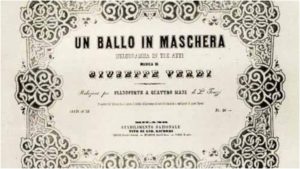
The 5 Greatest Musical Moments in Verdi’s ‘Un Ballo in Maschera’
By David Salazar“Un Ballo in Maschera” is one of Verdi’s finest operas of his middle period.
The libretto, while still rife with questionable melodramatic touches, features a compelling central character in the form of Riccardo / Gustavo. But more interestingly is the way that Verdi’s musical language has evolved throughout this particular work. “Ballo” is rife with glorious music that would easily be the masterpiece of lesser composers.
From its opening prelude to its fantastic finale, here is a look at the five greatest musical moments of “Un Ballo in Maschera.”
A Final Goodbye
Right before he gets shot down by his best friend Renato, Riccardo gets a chance to engage in one final love duet with his beloved Amelia. The two are talking amidst the ball, with the music of a mazurka dominating the proceedings. The two “converse” with this music very much untouched, but as the two lovers become embroiled in their goodbye and the realization that they won’t see one another, the rhythm of the mazurka transforms to envelop their vocal lines. They are still “in” the world of the party, but also very much in their own world. It’s as if Verdi went from a wide shot to an intimate closeup. The characters are still in the same environment but the camera has zeroed in on them.
Love Duet
How often did Verdi truly right a gloriously compelling love duet? If you look through his career, you can actually count that on one hand. “Otello” certainly springs to mind, but “Ballo” would likely be in second place. And the beauty of this duet is how it takes the two part structure and just plays with it. The first half develops the characters and their emotions brilliantly with Riccardo pressing on and Amelia resisting. Then finally, in an evocative moment of transformation she announces her love. And then all goes silent. Riccardo ushers in the second section of the duet after, in character, calling for all to crumble in the name of his love. The second duet has the two characters trade the main melody before coming together, their emotions still oceans apart. It retains a sense of ambiguity while still being extremely compelling.
A Baritone’s Angry Lament
This opera has a ton of great arias for the four major soloists. But “Eri tu” stands out for its complexity of emotion. Whereas Riccardo and Amelia’s arias develop the same emotion throughout, Renato’s aria sees him go from aggressive and angry to nostalgic, pained, and longing. The melodies themselves are forever memorable, which no doubt adds to the aria’s importance, but it is Verdi’s economic ability to fuse emotions so seamlessly that brings this one over the top.
Quintet
The opera actually has two quintets. While we undeniably love the latter one that dictates the death of Riccardo, it is the first and more famous “E scherzo od è follia” that takes the cake. The section is fascinating in its sense of ambiguity, the tenor’s opening passage written without any clear indication about his feelings toward the condemning prophecy. Is he afraid or does he see this as a joke? The text matches the music. The melody would suggest scherzo while the truncated vocal line expresses hesitation that accompanies a sense of fear. The tenor’s cheerful tune eventually dissipates into something more dramatic in nature, climaxing in Oscar’s high cry. The tenor’s line eventually returns to the forefront, but the sense of dread seemingly overpowers it. And yet the orchestra’s bouncy accompaniment makes it impossible to feel completely ill at ease throughout. Throw in the contrasting voices, three lower sounds coupled with two higher voices and you get a stronger mix of ambiguity.
Picking the Murderer
Verdi’s ability to create tension through his orchestration is generally underrated heavily and the selection of the murder is one such example. Just listen to this passage starting at around 1:37:40, during which a single brass instrument repeats the same musical figure over and over, rising more and more to create tension. Beneath it we hear an ostinato rhythm in the lower basses and horns while the strings repeat a similar ornamentation as an accent. The music builds and builds to the interruption by Amelia. The soprano gets a characteristic vocal phrase and then the motif returns in a newer manner, more stately and agitated. Then timpani strikes force Amelia into picking the murderer, the brass motif returning in violent fashion over orchestra rumbling. Then it dies down and waits in silence. It’s tension-wracked and just an incredible way of showing Verdi’s economic genius. What makes it all the more brilliant is how the same trio bookends the passage with the soprano given a contrasting vocal line to complete the scene.
What is your favorite musical moment from “Un Ballo in Maschera?” Let us know in the comments below!


